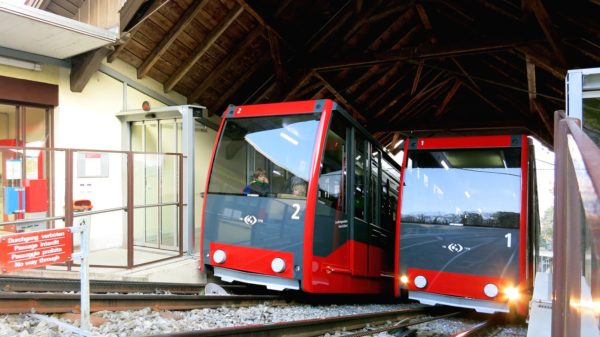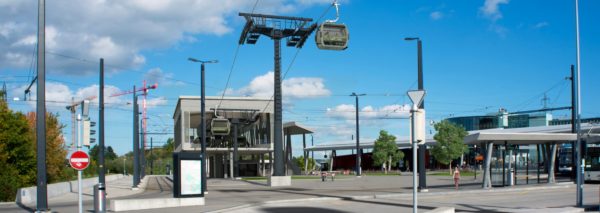
Cities, SI Urban 1/2021, Tourism
Interview: ,,The level of strain is too low!”
SI Urban: Mr Stückelberger, are urban cable cars already making a difference in Switzerland?
Ueli Stückelberger: Yes and no. For one thing, we have a strong tradition of funicular railways. These were often the very first urban mode of transport, as they were the most able to overcome the topographical challenges. For decades, funicular railways have served well as local public transport for everyday and tourist purposes in cities and towns such as Zurich, Bern, St. Gallen and Biel. Aerial cableways, on the other hand, are a new, controversial topic.

VÖV
For decades, funicular railways have served well in cities and towns such as Zurich, Bern, St Gallen and Biel. Photo: Biel funicular railway
Why? Switzerland is a model country for aerial cableways – especially in the mountains.
That’s right. In the valleys and mountains, aerial cableways have been used as public transport for decades – sometimes even as the only year-round connection between villages.
Around 20 of the 2,500 Alpine cable cars are used primarily as everyday public transport. They form part of our national fare system in Switzerland, operate on a timetable all year round and are subsidised by the state. But cable cars directly in cities have a more difficult time in Switzerland.
If the experience in rural areas is so good, why are urban cable car projects failing?
The biggest obstacle is the consent of the landowners. This impedes many projects. And even if they agree, there are bound to be neighbours who are against them. Many Swiss people are convinced that a cable car would disturb their privacy, damage the scenery and create noise. Furthermore, the purpose of such a transport solution is often questioned.
In the valleys of Switzerland, aerial cableways, such as here between have been Lauterbunnen and Mürren, have been used as public transport for decades. Photo: Surrer/SI Urban

Whether obscured windows, carefully considered routes or quiet drives, there are many arguments to counter these fears. Moreover, a cable car is often the most affordable solution.
That is true but the level of strain is too low. In Latin America, urban cable cars run over built-up areas as a matter of course, as they are useful, affordable and accepted.
In Switzerland though, in comparison with other countries, we have sufficient financial resources to choose more expensive alternatives, such as trams or road tunnels. We prefer to accept additional costs rather than argue over an urban cable car.
So it is difficult for anything that travels overground?
Exactly. Cable car technology itself is regarded very positively in Switzerland, but not the use of air space and land. We live in close proximity to one another and are constrained by the topography. Consequently, all transport, including buses and railways, has to use the existing space.
New developments are frowned on: transport should use existing routes – or simply go straight underground.
Stückelberger sees the planned zoo cable car in Zurich as a good example of a point-to-point connection. Photo: Zooseilbahn.ch

Is Switzerland wasting potential here?
Yes and no. I do not believe that cable cars alone can form a viable transport network but they are very suitable as a point-to-point connection. The planned zoo cable car in Zurich is a good example; it could transport visitors quickly and continuously from the suburban railway station to the zoo all day long, whereas the tram takes a long time.
However, when it comes to transport destinations with peak times, such as schools, I am sceptical. I think a cable car quickly reaches the limits of its transport capacity in this case. Furthermore, I see cable cars with more than two stations as questionable in Switzerland, as they bring us back to the problem of land use.
So what are the prospects for urban cable cars?
Whether in Zurich, Basel, Geneva, Freiburg or Lucerne- Kriens, there are many good ideas for urban cable cars but the projects unfortunately rarely make progress. The cable car is certainly an attractive mode of transport here – and easily comparable with other mobility solutions.
However, where there is strong demand, we already have good access using other modes of transport, and a cable car is also unprofitable where passenger numbers are low. I therefore think that the best opportunity for cable cars lies in mobility hubs.
In what respect?
Cable cars need to blend with other modes of transport. The bottom station of the cable car in Fiesch is a real showcase project in this respect; passengers here can connect directly from the railway to the gondolas. A cable car needs to be a part of the public transport network. The more integrated it is, the more accepted it will be.
The interview was conducted by Thomas Surrer (ts).







